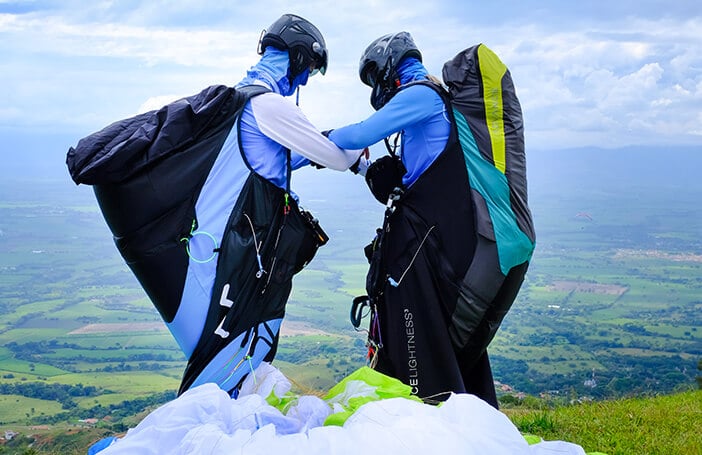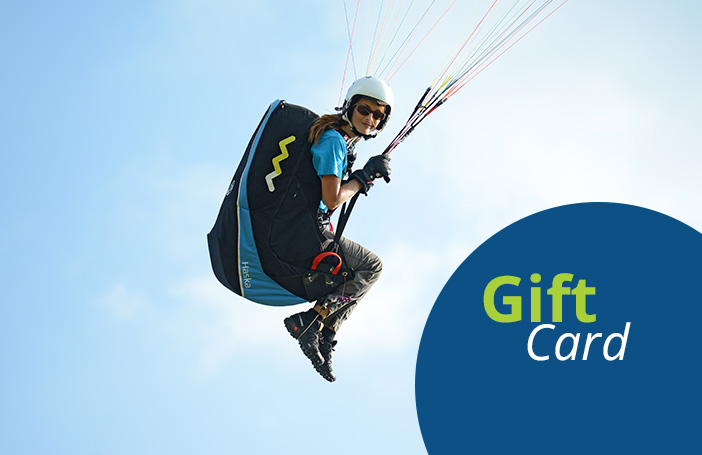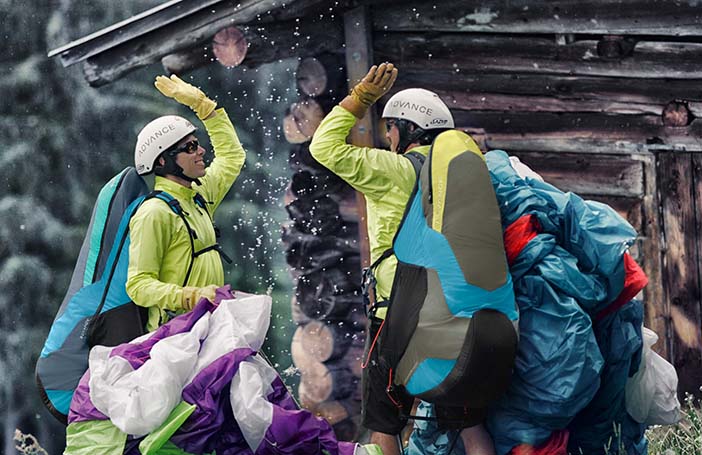Technical data
| SIZE |
XS |
S |
M |
ML |
L |
| WEIGHT RANGE (KG) |
55-75 |
65-85 |
75-95 |
85-110 |
100-125 |
| FLAT AREA (M²) |
21 |
23 |
25 |
27 |
29 |
| PROJECTED AREA (M²) |
17.7 |
19.6 |
21 |
22.7 |
24.5 |
| FLAT ASPECT RATIO |
5.2 |
| PROJECTED ASPECT RATIO |
3.6 |
| CELLS |
45 |
| GLIDER WEIGHT (KG) |
3.4 |
3.6 |
3.9 |
4.1 |
4.4 |
| LINEAR SCALING FACTOR |
0.92 |
0.96 |
1 |
1.04 |
1.08 |
| TOTAL LINE LENGTH (M) |
227 |
233 |
244 |
254 |
263 |
| HEIGHT (M) |
6.4 |
7 |
7.1 |
7.3 |
7.5 |
| NUMBER OF MAIN LINES (A/B/C) |
3/4/3 |
| ROOT CHORD (M) |
2.5 |
2.7 |
2.7 |
2.8 |
2.9 |
| FLAT SPAN (M) |
10.4 |
10.9 |
11.4 |
11.8 |
12.3 |
| PROJECTED SPAN (M) |
8.2 |
8.5 |
8.9 |
9.3 |
9.6 |
| TRIM SPEED (KM/H) |
39 |
| TOP SPEED (KM/H) |
53 |
| MIN SINK (M/S) |
1 |
| BEST GLIDE |
9.5 |
| CERTIFICATION (EN/LTF) |
B |
Colours
Standard colours: Coral, Pine, Sand.
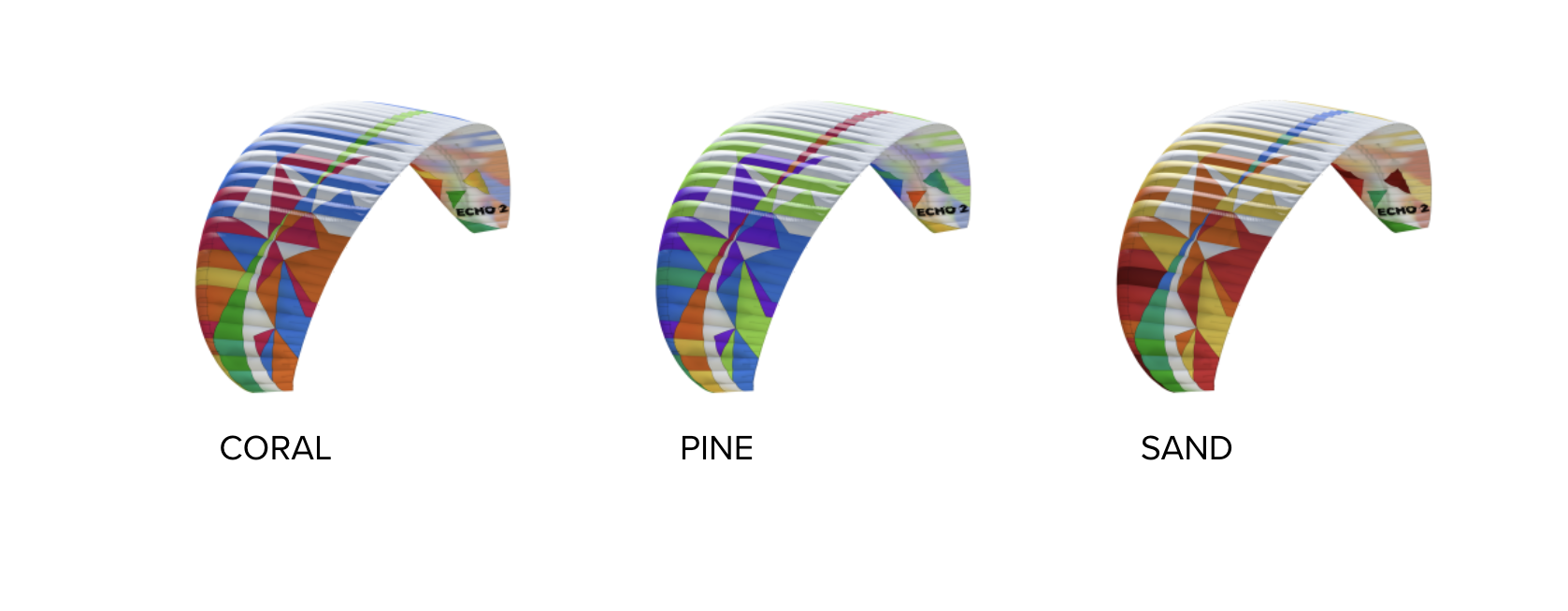
Package
- Paraglider
- BGD Gift
- Rucksack
- Repair kit
- Stuff sack
- Riser bag
- Compression strap
- Manuals
- BGD stickers
Echo 2: There and back
It folds down nice and small with no fussy packing techniques required. Cross-country? Absolutely. It’s still a safe and easy low-B, with great glide performance and more speed than the original ECHO. You can safely use the bar all the way, and it has a B/C- steering system so you can get in your groove on the bar, steer with the rears and munch those miles. Vol-Biv? Please do! The sheathed lines, easy-handling risers, and careful cloth choices mean ECHO 2 won’t wilt at the thought of a rocky launch. It’s easy to clear the lines to lay out in the wild, and the launch is easy. So take her into the mountains, ECHO 2 is at home there!
The weights in the Specs table are with softlinks. The ECHO 2 is supplied as standard with maillons; softlinks are available on request.
Target
ECHO 2 is a multi-purpose superstar, a quiver of one! Whether you’re a relative beginner or have 20 flying years under your belt, she’s safe and accessible, with fun handling and good performance. BGD founds a solution to the lightness/durability paradox with clever cloth combos that mean she’s light but still durable, and easy to handle too. So whether you fly locally, hike, travel, or vol-bivouac, the ECHO 2 is everything you need.
Flying level/style
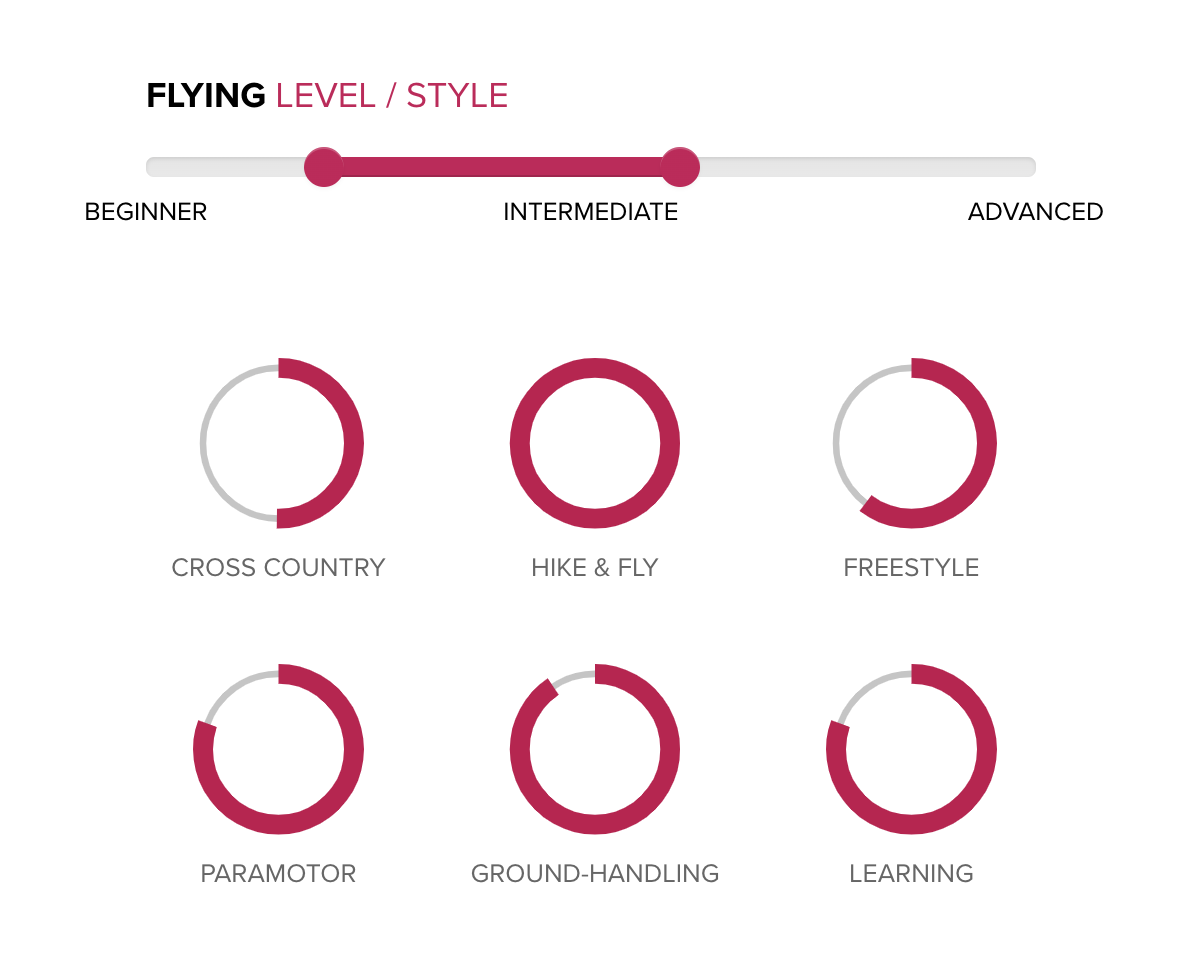
Designer's notes
With the ECHO 2 we wanted to make something nice and light, that is easy to fold and carry. At the same time, it had to be user-friendly, not too fragile and have really usable performance.
The ECHO 2 is made entirely from high quality and industry proven Porcher cloth, mostly in 27g/m2 weight for both surfaces. On the leading edge there is sturdy 38g/m2 cloth in the centre where it is needed for additional strength and to ensure longevity.
There are small rods in the leading edge, but none are very long, and there are no rods in the back of the sail so it’s easily foldable and can be packed small.
We opted for the same risers as are on the EPIC 2, because they are much easier to handle than Dyneema ‘rope’ style risers, and this wing is designed to be accessible to lower-airtime pilots. We also kept to sheathed lower lines for the same reason, especially for rocky or awkward launches. They are easier to see, so you can spot if they are caught around anything before you try to launch, and it means they can be colour coded so you can easily tell the lines apart.
We worked a LOT on perfecting the launch, and from the feedback we’re getting we reckon we got it right. The light sail comes up like a dream and settles over your head till you decide to go. No holding back or over-flying, and no hurtling forwards at high speed in strong winds. It’s easy and relaxing, just the way we like it!
While safety is always a priority with a low-B wing, the ECHO 2 included, we also wanted the ECHO 2 to have really usable performance. It is a bit faster than the original, and we’ve used a similar B/C steering system to that on the BASE 2, on the EPIC 2 and ECHO 2. You can safely explore the whole bar travel, and learn to correct your direction with the rear risers. There won’t be a lot of pitch-correction to manage with the ECHO 2, and rear-riser steering is a good method to get used to if you’re a newer pilot moving up through the glider levels. If you’d rather not use it yet, that’s fine. The way it’s designed it does not clutter the risers, and can be ignored until you’re ready.
Long brake travel helps avoid an accidental stall or spin, and the brakes are beautifully precise and direct. The handling is BGD through and through – playful and fun and the colours have crept onto the undersurface too for even more pzazz. (And as the pilot you get to see them too, bonus!)
Features
ALULA Simulation Software
The future of glider design depends largely on simulations. Instead of designing and producing prototypes one by one, BGD unique in-house structural / aero simulation program, ALULA, enables BGD to accurately simulate hundreds of virtual prototypes. They test over 200 virtual prototypes for each paraglider, using 50 million iterations of the structural / aero calculations.
B/C Speed Steering
The risers are equipped with a new ‘speed riser’. It attaches the back of the speed system to the front of the C-line steering handle. This balances the load on the C-steering handle, making the C-steering system simple and light to use. Because the force is on the dimensionally stable Kevlar-reInforced riser and not the pulley, the glider stays in trim.
BGD Feedback
Gliders that talk are safer. Safer gliders make pilots perform better. Better performing pilots fly further. Further flying pilots are happier pilots. BGD Feedback produces happier pilots!
Chord cut billow (CCB)
Chord Cut Billow technology has been developed to improve the form friction, glider stability and overall performance of BGD paragliders. Two seams run chord-wise across the top panels of the leading edge. They accommodate the panel ballooning that happens when the wing is inflated. Without CCB, up to five centimeters of excess material is created on the sides of an inflated flat panel when it bends over a wing profile. This results in wrinkles. Chord Cut Billow technology removes this excess material and the 3D panel has fewer ripples and improved rib profile shape and stability.
Low Weight and Pack size
BGD have used lightweight cloth, mostly Porcher 27g/m2, on both surfaces. The ribs and diagonals are all weight optimised, and there are no long or stiff rods in the sail, so the wing can be easily and compactly folded.
Multi-Plastics
By using different sizes of stiff black Perlon® and flexible orange plastic in specific places, they have optimised the rigidity and softness of the wing along the span to achieve optimal progressive stability.
Integrated Line Layout
The line layout of BGD gliders is fully integrated into the wing design. Sail and lines are designed together, holistically. The cell widths and the internal straps that transfer the load though the sail are all designed according to the line layout. Even the panel shaping is matched with the line layout though detailed CAD simulation. The result is simple: fewer lines and stronger, faster, safer gliders.
Progressive stability
Using ALULA, BGD gliders are designed to have a stable and solid center with progressively softer tips. This teaches pilots to predict and avoid deflations and stay aware of the air.
Snap Locks
Snap Locks are lightweight, compact attachments that connect the brakes to the risers. A small focused magnet inside the catch and an internal locking system hold the handle in place, releasing only if the handles are pulled down towards the pilot. This unique design feature means the handles don’t fall off while kiting, packing, or performing manoeuvres. The Snap Lock system solves many of the problems associated with press studs and magnets.
Triple finger diagonals
Triple Finger Diagonals create a more solid and durable wing. Across the whole chord of the profile, three-piece diagonal supports pass through holes in the ribs. They ensure structural integrity by avoiding the cloth being loaded in the bias direction. This is particularly important near the trailing edge where the profile is thin and shallower diagonal ribs supporting high loads.
Weight-optimised ribs
BGD have maintained the strength and rigidity of the ribs while removing unnecessary material. This means less weight for no increase in cost or reduction in strength of the wing. The hole positioning and size depends on the loads taken locally by the sail, and it is thanks to recent developments in BGD software that it is now possible to accurately calculate this.
Flybubble review
The ECHO 2 is BGD's lightweight version of the EPIC 2.
Our review of the BGD EPIC 2:
"The BGD Epic 2 is a low B wing that feels just right for the low B class. It's easy to lunch and fly, it's got fun handling, nice feedback and very good performance. I think it's the perfect glider for ambitious-new and recreational pilots, who are just wanting something nice and easy low B glider, that gives them more fun, enjoyment and good performance, but don't want to go on high B wing.
If you are looking for a top performer in the low B class, certainly of all the wings I tried, then I think the EPIC 2 has very good performance. If your priorities are more on the easiness and the easy launch and fun flying, then the Epic 2 is fantastic for that side of stuff. If you are wanting to get into the freestyle and acro, I would give the Epic 2 a slight advantage in that regard. If you are a pilot that's looking for more on the fun side and playful, playing around with your glider I think the EPIC 2 is a really good choice for that. One thing that I really like in the Epic 2, is that they added a BC system onto this low B glider. If the performance isn't your top priority in the low B class and you want ease of use instead, then the Epic 2 wins for that on the BC system.
Flying next to a whole variety of gliders, thermalling, gliding, soaring along the ridge, I had the impression that Epic 2 has a little more agile, sporty feeling. It's got a slightly go-kart feeling about it, which for me is really fun and enjoyable.
Epic 2 has got an all round good characteristic for the thermalling and handling, so copes well enough in weak punchy stuff. In strong punchy stuff it was able to turn nice and tight. That you really want as a pilot, when you're flying in a variety of conditions.”
— Carlo Borsattino, Flybubble
Watch the video review of Epic 2
Materials
- TOP SURFACE: Porcher Skytex 27g/m², 38g/m²
- BOTTOM SURFACE: Porcher Skytex 27g/m²
- INTERNAL STRUCTURE :Porcher Skytex hard finish 32g/m²
- NOSE REINFORCING: Plastic wire 2,3 / 2,7mm
- RISERS: 12mm Kevlar / Nylon webbing
- PULLEYS: Allen
- TOP LINES: Edelrid 8000U
- MIDDLE LINES: Edelrid 8000U
- LOWER LINES: Edelrid PPSL and TSL
- BRAKES: Liros DSL, PPSL
Downloads
See here for all the latest manuals, certifications, and other documentation
Manual
Certification
| Certificate |
|
|
|
|
|
| Flight report |
XS |
|
|
|
L
|
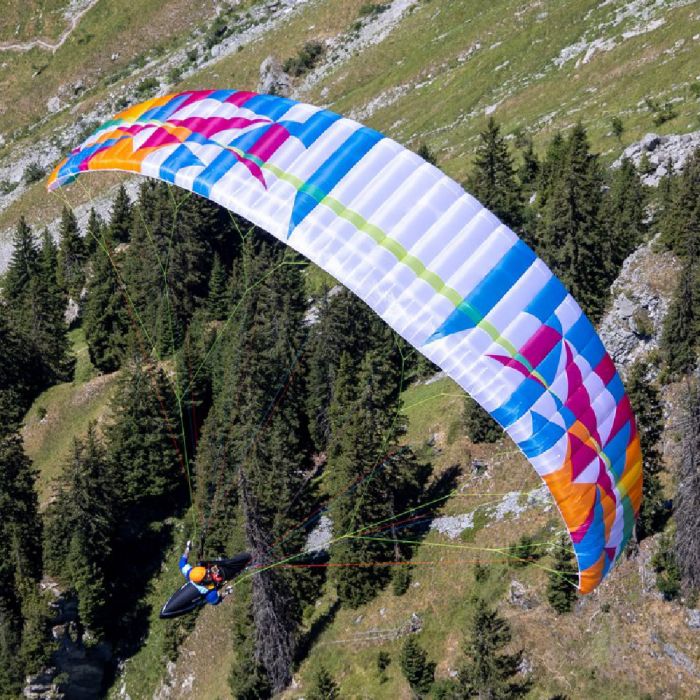
![]()





